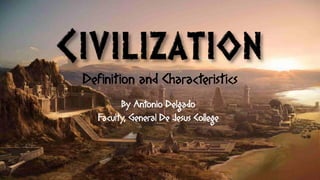
Civilization: Definition and Characteristics
- 1. Definition and Characteristics By Antonio Delgado Faculty, General De Jesus College
- 2. How is civilization defined? Distinguish civilization from “kabihasnan”. What are the seven major first civilizations? What are the different characteristics of civilization? How are these characteristics exemplified in the oldest civilization: Sumer (Mesopotamia)?
- 3. Latin word meaning “city”
- 4. According to Beck, et al (2009), it is a complex culture with five characteristics: 1. Advanced cities 2. Specialized workers 3. Complex institutions 4. Record keeping 5. Advanced technology
- 5. Cities were the birthplaces of civilizations. Although Strayer & Nelson (2016) describes a city as having a population in the tens of thousands, a city is more than a large group of people living together. It is a center of trade.
- 6. c. 3800 – 500 BCE
- 7. c. 3800 – 500 BCE
- 8. c. 4500 BCE
- 9. Population: 40,000 – 80,000 “first true city”
- 11. specialization – development of skills in a specific kind of work artisans – skilled workers who make goods by hand
- 12. Standard of Ur (c.. 2600 BCE)
- 13. institution – long-lasting pattern of organization in a community Examples: government, religion
- 15. Code of Ur-Nammu
- 17. cuneiform – first system of writing invented by the Sumerians around 3000 BCE pictographs – symbols of the objects or what they represented scribes – professional record keepers
- 18. clay tablet with cuneiform writing
- 19. “wedge-shaped”
- 20. clay tablet and stylus
- 22. quipu – system of record keeping of the Incans which used a set if colored strings tied with different-sized knots at various intervals
- 23. Example of quipu from Larco Museum Collection
- 24. technology – refers to the people’s use of tools and processes to make their work faster and easier.
- 27. plow
- 28. textile mill
- 30. Ur-Nammu as Basket Carrier, c. 2111 - 2905 BCE
- 31. c. 3000 – 1200 BCE
- 33. According to CrashCourse (2012), it is a social order with four or more of the following “symptoms”: Surplus production City Specialization of labor Trade Social stratification Centralized government Shared values (religion) Writing
- 34. surplus - agricultural produce or a quantity of food grown in excess of one’s needs
- 36. For our course, these are the characteristics of a civilization: 1. Advanced cities 2. Surplus production 3. Specialization 4. Social stratification 5. Government 6. Belief system 7. Economy 8. Record keeping 9. Advanced technology 10. Associated with a river
- 39. 1. Mesopotamian Civilization (Sumerian) – Tigris and Euphrates 2. Nile Valley Civilization (Old Kingdom) – Nile 3. Indus Valley Civilization – Indus and Sarasvati (Ghaggar-Hakkar) River 1. Chinese Civilization (Shang dynasty) – Huang He and Yangtze (Chiang Jiang) These are known as the Four Great River Valley civilizations.
- 40. Tigris
- 41. Euphrates
- 42. Euphrates
- 43. Nile River
- 44. Indus
- 47. Huang He
- 48. Chiang Jiang
- 49. Chiang Jiang
- 50. 5. Norte Chico Civilization – Supe River 6. Mesoamerican Civilization (Olmec) – Coatzacoalcos River 7. Oxus Civilization – Amu Darya
- 52. In Filipino, “sibilisasyon” has a different meaning from “kabihasnan”. The word “kabihasnan” comes from the word “bihasa”
- 53. It is a society that has a high standard of living, an organized government, religion, a system of labor, and social stratification (Cruz, et al, 2015).
- 54. According to Cruz, et al (2015), there are five standards by which by which the presence of a “kabihasnan” may be measured: 1. Government 2. Economy 3. Religion 4. System of Writing 5. Advanced level of technology
- 56. Boxer Codex (c. 1590)
- 57. Civilization is a reflection of who we are and what we value (Osborne, 2006). “Hindi sibilisado.” “Taga-bundok” “Barbarian” – anyone who did not speak ancient Greek Civilization is an intellectual construct (CrashCourse, 2012).
- 60. Beck, R. et al (2009). World History: Patterns of Interaction. Boston, MA: Houghton Mifflin Harcourt Publishing Company, pages 14 – 25 CrashCourse. (2012, February 2). Indus Valley Civilization: Crash Course World History #2 [Video File]. Retrieved from https://www.youtube.com/watch?v=n7ndRwqJYDM Cruz, A. et al (2015). World History. Quezon City: Vibal Group, Inc., pages 43 – 44 Strayer, R. & Nelson, E. (2016). Ways of the World: A Brief Global History with Sources (3rd ed.). Boston, MA: Bedford/St. Martin’s. pages 24 – 47
